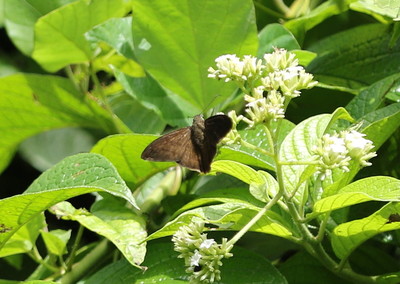Hesperiidae : Eudaminae
Telegonus anausis (Godmin & Salvin, 1896)
Caribbean Yellow-tipped Flasher
Telegonus anausis (Godmin & Salvin, 1896)
Caribbean Yellow-tipped Flasher
Previously known as: Astraptes anaphus and Telegonus anaphus. This species has now been renamed Telegonus anausis in line with Zhang et al (2020). You can read the paper here.
Description and Similar Species: Wingspan 50-64mm. Sexes similar. A large brown skipper with some dark barring and no translucent spots. Note that the subspecies found on the Caribbean Islands lacks the broad yellowish band on the trailing edge of the under hindwing shown on mainland specimens.
Range: Mexico to South America and many of the Caribbean islands.
Status: In Cuba it is rare found mainly in the far east of the island but also in Pinar del Rio, Habana and Sancti Spiritus provinces in woodland rides, edges and clearings.
Nectar Plants: Ageratum, Bidens pilosa, Cordia, Lantana and Tournefortia etc.
Larval Foodplants: Lablab purpureus and Mucuna pruriens (Fabaceae). On the mainland and Jamaica it has been found on other species of beans. In Costa Rica larvae have been found on Canavalia oxyphylla (Fabaceae).
Description and Similar Species: Wingspan 50-64mm. Sexes similar. A large brown skipper with some dark barring and no translucent spots. Note that the subspecies found on the Caribbean Islands lacks the broad yellowish band on the trailing edge of the under hindwing shown on mainland specimens.
Range: Mexico to South America and many of the Caribbean islands.
Status: In Cuba it is rare found mainly in the far east of the island but also in Pinar del Rio, Habana and Sancti Spiritus provinces in woodland rides, edges and clearings.
Nectar Plants: Ageratum, Bidens pilosa, Cordia, Lantana and Tournefortia etc.
Larval Foodplants: Lablab purpureus and Mucuna pruriens (Fabaceae). On the mainland and Jamaica it has been found on other species of beans. In Costa Rica larvae have been found on Canavalia oxyphylla (Fabaceae).
Larva
Foodplants and Habitat





